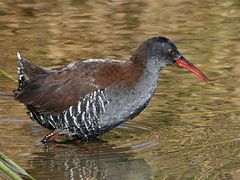Rallus
| Rallus[1] | |||
| Linnaeus, 1758[2] | |||
 Wodnik afrykański (R. caerulescens) | |||
| Systematyka | |||
| Domena | |||
|---|---|---|---|
| Królestwo | |||
| Typ | |||
| Podtyp | |||
| Gromada | |||
| Infragromada | |||
| Rząd | |||
| Nadrodzina | |||
| Rodzina | |||
| Podrodzina | |||
| Rodzaj |
Rallus | ||
| Typ nomenklatoryczny | |||
|
Rallus aquaticus Linnaeus, 1758 | |||
| Synonimy | |||
|
| |||
| Gatunki | |||
| |||
Rallus – rodzaj ptaków z rodziny chruścieli (Rallidae).
Zasięg występowania
Rodzaj obejmuje gatunki występujące w Ameryce, Eurazji i Afryce[6].
Morfologia
Długość ciała 20–48 cm; masa ciała samców 64–490 g, samic 67–400 g[6].
Systematyka
Etymologia
- Rallus (Ralus): BOU (1915) twierdzi, że nazwa ta jest „zlatynizowaną formą francuskiego Rale, naszego Rail, holenderskiego Ral”, zaś Macleod w 1954[7] roku zauważa, że nazwa ta jest „zlatynizowaną formą niemieckiego ralle, wodnik (ptak)”[8].
- Biensis: łac. bi- „podwójnie”, od bis „podwójny”; ensis „miecz”; aluzja do cienkiego dzioba wodnika madagaskarskiego, który jest dwa razy dłuższy niż jego głowa[9]. Gatunek typowy: Biensis typus Pucheran, 1845 = Rallus madagascariensis J. Verreaux, 1833.
- Epirallus: gr. επι epi „blisko, poza”; rodzaj Rallus Linnaeus, 1758[10]. Gatunek typowy: †Epiralus notatus Miller, 1942.
Podział systematyczny
Do rodzaju należą następujące gatunki[11]:
- Rallus obsoletus Ridgway, 1874 – wodnik kalifornijski – takson wyodrębniony ostatnio z R. longirostris[12]
- Rallus tenuirostris Ridgway, 1874 – wodnik cienkodzioby – takson wyodrębniony ostatnio z R. elegans[12]
- Rallus longirostris Boddaert, 1783 – wodnik długodzioby
- Rallus elegans Audubon, 1834 – wodnik królewski
- Rallus crepitans J.F. Gmelin, 1789 – wodnik karoliński – takson wyodrębniony ostatnio z R. longirostris[12]
- Rallus wetmorei J.T. Zimmer & W.H. Phelps, Sr., 1944 – wodnik wenezuelski
- Rallus limicola Vieillot, 1819 – wodnik błotny
- Rallus semiplumbeus P.L. Sclater, 1856 – wodnik andyjski
- Rallus antarcticus P.P. King, 1828 – wodnik patagoński
- Rallus aquaticus Linnaeus, 1758 – wodnik zwyczajny
- Rallus indicus Blyth, 1849 – wodnik brązowopierśny – takson wyodrębniony ostatnio z R. aquaticus[13][14]
- Rallus caerulescens J.F. Gmelin, 1789 – wodnik afrykański
- Rallus madagascariensis J. Verreaux, 1833 – wodnik madagaskarski
oraz gatunki wymarłe:
- Rallus eivissensis McMinn, Palmer & Alcover, 2005
- Rallus polgardiensis Zelenkow, 2017 – kopalny, mioceński gatunek[15]
Uwagi
- ↑ Niepoprawna późniejsza pisownia Rallus Linnaeus, 1758.
Przypisy
- ↑ Rallus, [w:] Integrated Taxonomic Information System (ang.).
- ↑ C. Linnaeus: Systema naturae per regna tria naturae, secundum classes, ordines, genera, species, cum characteribus, differentiis, synonymis, locis. Wyd. 10. T. 1. Holmiae: Impensis Direct. Laurentii Salvii, 1758, s. 153. (łac.).
- ↑ L.J.P. Vieillot: La galerie des oiseaux. Paris: Constant-Chantpie, 1825, s. 168. (fr.).
- ↑ J. Pucheran. Notes sur quelques espèces Madécasses de l’ordre des Écuassiers. „Revue Zoologique”. 8, s. 278, 1845. (fr.).
- ↑ L.H. Miller. Two new bird genera from the Pleistocene of Mexico. „University of California publications. Zoology”. 47 (3), s. 43, 1942. (ang.).
- ↑ a b P.B. Taylor: Family Rallidae (Rails, Gallinules and Coots). W: J. del Hoyo, A. Elliott & J. Sargatal: Handbook of the Birds of the World. Cz. 3: Hoatzin to Auks. Barcelona: Lynx Edicions, 1996, s. 167–170. ISBN 84-87334-20-2. (ang.).
- ↑ R.D. Macleod: Key to the Names of British Birds. London: Pitman, 1954, s. 43. (ang.).
- ↑ Rallus, [w:] The Key to Scientific Names, J.A. Jobling (red.), [w:] Birds of the World, S.M. Billerman et al. (red.), Cornell Lab of Ornithology, Ithaca [dostęp 2022-02-02] (ang.).
- ↑ Biensis, [w:] The Key to Scientific Names, J.A. Jobling (red.), [w:] Birds of the World, S.M. Billerman et al. (red.), Cornell Lab of Ornithology, Ithaca [dostęp 2022-02-02] (ang.).
- ↑ Epirallus, [w:] The Key to Scientific Names, J.A. Jobling (red.), [w:] Birds of the World, S.M. Billerman et al. (red.), Cornell Lab of Ornithology, Ithaca [dostęp 2022-02-02] (ang.).
- ↑ Systematyka i nazwy polskie za: P. Mielczarek & M. Kuziemko: Rodzina: Rallidae Leach, 1820 - chruściele - Rails and Coots (wersja: 2024-01-24). [w:] Kompletna lista ptaków świata [on-line]. Instytut Nauk o Środowisku Uniwersytetu Jagiellońskiego. [dostęp 2024-12-17].
- ↑ a b c J. Maley & R.T. Brumfield. Mitochondrial and next-generation sequence data used to infer phylogenetic relationships and species limits in the Clapper/King Rail complex. „Condor”. 115 (2), s. 316–329, 2013. DOI: 10.1525/cond.2013.110138. (ang.).
- ↑ P.C. Rasmussen & J.C. Anderton: Birds of South Asia: The Ripley Guide. Cz. 2. Waszyngton i Barcelona: Smithsonian Inst. and Lynx Edicions, 2005. ISBN 84-87334-67-9. (ang.).
- ↑ E.S. Tavares, G.H.J. de Kroon & A.J. Baker. Phylogenetic and coalescent analysis of three loci suggest that the Water Rail is divisible into two species, Rallus aquaticus and R. indicus. „BMC Evolutionary Biology”. 10, s. 226, 2010. DOI: 10.1186/1471-2148-10-226. PMID: 20653954. (ang.).
- ↑ Nikita Zelenkow. Revision of non-passeriform birds from Polgárdi (Hungary, Upper Miocene): 3. Neoaves. „Paleontological Journal”. 51 (2), s. 203–213, 2017. DOI: 10.1134/S0031030117020162. (ang.).
